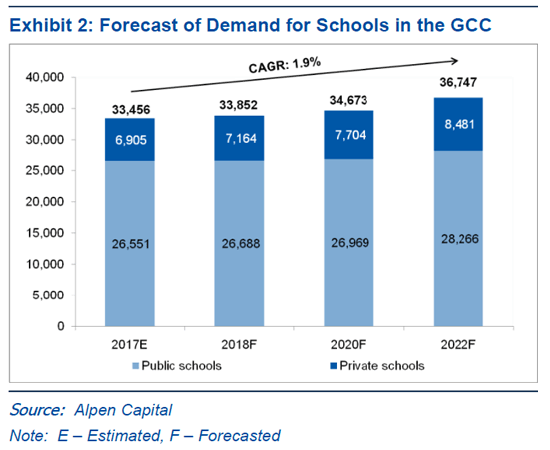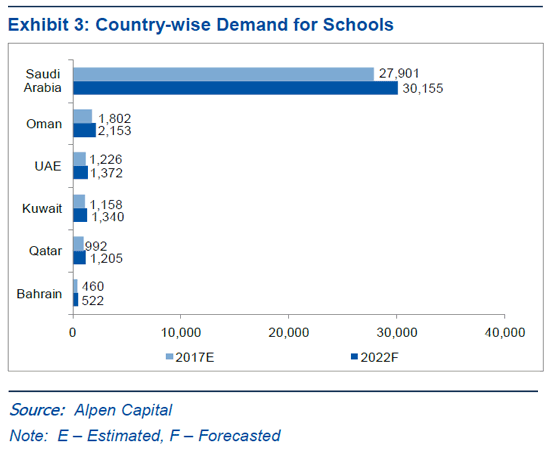“The GCC education sector is continuing to grow on account of a rising population coupled with the growing preference for private education. Despite a slowdown in economic growth, regional governments have continued to allocate sizeable portions of their budgets to the education sector. Development of the education sector has remained a top priority for the governments across the GCC region as the regional governments recognize the importance of investing in skills and training to provide employment opportunities and boost overall competitiveness. The sector is however facing intensifying competition, oversupply, high operational costs and a shortage of teachers, which collectively, are contributing to the increasing pressure on demand” says Sameena Ahmad, Managing Director, Alpen Capital (ME) Limited.
“Decline in oil prices resulted in challenging macroeconomic conditions for the GCC countries and forced the regional economies to exercise fiscal discipline. Cost rationalization and consolidation exercised by corporates and institutions have resulted in job losses and pressure on demand across industries, including the education sector. Recent pick-up in oil prices is expected to bring new energy for infrastructural spending and business activities. Additionally, there is considerable opportunity for consolidation in the segment which, along with favourable demographics, high disposable income and growing awareness for quality education, is likely to play a pivotal role going forward”, says Mahboob Murshed, Managing Director, Alpen Capital (ME) Limited
Industry Outlook
According to Alpen Capital, the total number of students in the GCC education sector is projected to reach 14.5 million in 2022, registering a CAGR of 2.3% from an estimated 12.9 million in 2017. A growing school age population, high per capita income, continued government spending and long term strategic government initiatives is expected to drive the future growth of the GCC education sector.
Between 2017 and 2022, the pre-primary and tertiary segments is expected to grow at a faster rate than the other segments. The pre-primary segment is expected to grow at a CAGR of 3.7%, whereas the tertiary segment is witness growth at a CAGR of 3.6%. Primary and secondary segments are expected to witness a moderate growth rate of 1.8% and 2.0% CAGR, respectively.

The number of students in private schools is projected to grow at a CAGR of 4.1%, whereas enrolments at public schools is likely to increase at a slower pace, recording a CAGR of 1.3% between 2017 and 2022.
Saudi Arabia is expected to remain the largest education market in the GCC in 2022. In terms of annualized growth, the number of students in Oman and Qatar is projected to grow at a faster rate than the other member nations. The Kingdom of Saudi Arabia is also anticipated to account for the highest number of schools in GCC by 2022.
The demand for public and private schools in the GCC region is likely to increase at a CAGR of 1.9% to 36,747 by 2022, reflecting a requirement of more than 3,200 schools over the next five years. The demand for public schools in the GCC is expected to increase at a CAGR of 1.3% whereas the demand for private schools is anticipated to grow at a CAGR of 4.1% between 2017 and 2022.


To download the report, please click here.

 Back
Back